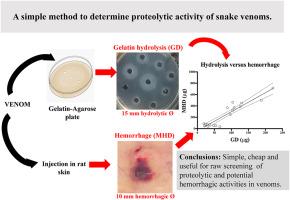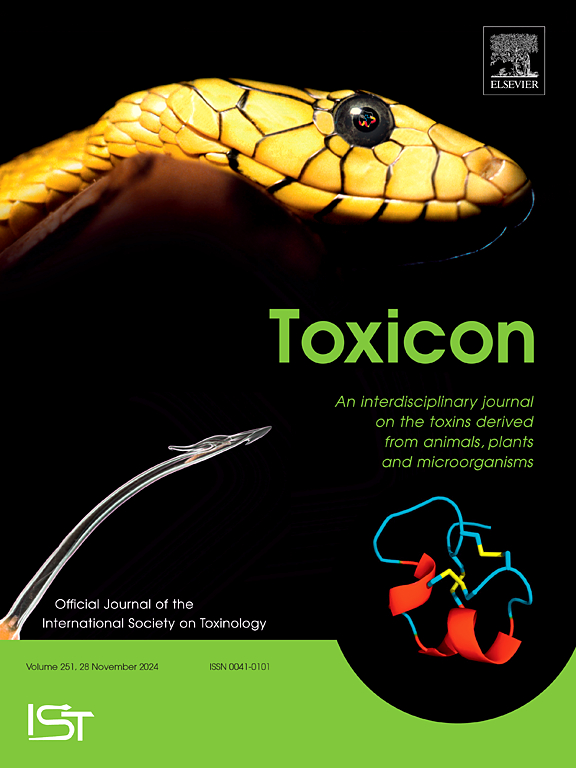A simple method to determine proteolytic activity of snake venoms
IF 2.6
4区 医学
Q2 PHARMACOLOGY & PHARMACY
引用次数: 0
Abstract
In this work, we describe an easy, simple, and cost-effective method to assess the proteolytic activity of snake venoms. The method is based on measuring the hydrolytic halo formed by gelatin radial hydrolysis following the incubation of venoms on a solid gelatin-agarose plate. Venoms from Bothrops (B.) alternatus, B. diporus, B. neuwiedi, B. jararaca, B. jararacussu, Crotalus atrox, and Trimeresurus albolabris were tested. A dose-response relationship was observed for each venom tested, with proteolytic capacity values, determined as GD (gelatinolytic dose, the dose causing a 15 mm hydrolytic halo) ranging from 21 to 222 μg. A correlation between hydrolysis and hemorrhagic activity in rat skin (minimal hemorrhagic dose) was found, with an r2 value of 0.8774 (p < 0.0001). The venoms’ hydrolytic activity was significantly, though not completely, inhibited by EDTA. This methodology was also deployed to assess venom neutralization by antivenoms on the hydrolytic activity of the different venoms, demonstrating its usefulness in evaluating antivenom neutralizing capacity. The method presented is simple, cheap and useful for preliminary screening of venom proteolytic activity and its inhibition and may also predict gross differences in hemorrhagic activity, contributing to the reduction of the number of animals used for these determinations.

测定蛇毒蛋白水解活性的简单方法。
在这项工作中,我们介绍了一种简便易行、经济高效的方法来评估蛇毒的蛋白水解活性。该方法基于测量明胶-琼脂糖固体平板上的毒液培养后明胶径向水解形成的水解晕。该方法测试了两种蛇(B. alternatus、B. diporus、B. neuwiedi、B. jararaca、B. jararacussu、Crotalus atrox 和 Trimeresurus albolabris)的毒液。对每种毒液的测试都观察到了剂量-反应关系,蛋白水解能力值(以 GD(凝胶溶解剂量,导致 15 毫米水解光晕的剂量)表示)从 21 微克到 222 微克不等。水解作用与大鼠皮肤出血活性(最小出血剂量)之间存在相关性,r2 值为 0.8774(p < 0.0001)。乙二胺四乙酸(EDTA)对毒液的水解活性有明显的抑制作用,但并不完全。该方法还用于评估抗蛇毒血清对不同毒液水解活性的中和作用,证明了其在评估抗蛇毒血清中和能力方面的实用性。所介绍的方法简单、廉价,可用于毒液蛋白水解活性及其抑制作用的初步筛选,还可预测出血活性的显著差异,有助于减少用于这些测定的动物数量。
本文章由计算机程序翻译,如有差异,请以英文原文为准。
求助全文
约1分钟内获得全文
求助全文
来源期刊

Toxicon
医学-毒理学
CiteScore
4.80
自引率
10.70%
发文量
358
审稿时长
68 days
期刊介绍:
Toxicon has an open access mirror Toxicon: X, sharing the same aims and scope, editorial team, submission system and rigorous peer review. An introductory offer Toxicon: X - full waiver of the Open Access fee.
Toxicon''s "aims and scope" are to publish:
-articles containing the results of original research on problems related to toxins derived from animals, plants and microorganisms
-papers on novel findings related to the chemical, pharmacological, toxicological, and immunological properties of natural toxins
-molecular biological studies of toxins and other genes from poisonous and venomous organisms that advance understanding of the role or function of toxins
-clinical observations on poisoning and envenoming where a new therapeutic principle has been proposed or a decidedly superior clinical result has been obtained.
-material on the use of toxins as tools in studying biological processes and material on subjects related to venom and antivenom problems.
-articles on the translational application of toxins, for example as drugs and insecticides
-epidemiological studies on envenoming or poisoning, so long as they highlight a previously unrecognised medical problem or provide insight into the prevention or medical treatment of envenoming or poisoning. Retrospective surveys of hospital records, especially those lacking species identification, will not be considered for publication. Properly designed prospective community-based surveys are strongly encouraged.
-articles describing well-known activities of venoms, such as antibacterial, anticancer, and analgesic activities of arachnid venoms, without any attempt to define the mechanism of action or purify the active component, will not be considered for publication in Toxicon.
-review articles on problems related to toxinology.
To encourage the exchange of ideas, sections of the journal may be devoted to Short Communications, Letters to the Editor and activities of the affiliated societies.
 求助内容:
求助内容: 应助结果提醒方式:
应助结果提醒方式:


